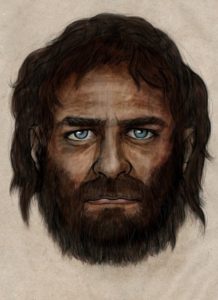
Researchers in Spain recovered and studied a genome of a Mesolithic period European hunter-gatherer, and concluded that he had blue eyes and dark skin.
Designated La Braña 1, the specimen was unearthed at the La Braña-Arintero site in Valdelugueros (León, Spain), where the remains of at least one other skeleton was uncovered. They were discovered by chance in 2006 and excavated by Julio Manuel Vidal Encinas, an archeologist with the Council of Castilla y León. The cave, located in a cold mountainous area with a steady temperature and 1,500 meters below sea level, contributed to the “exceptional” preservation of the DNA from the two individuals found inside, called La Braña 1 and La Braña 2, respectively.
The remains were determined to be 7,000 years old, placing them well within the Mesolithic Period. The Mesolithic lasted 5,000 years (between the Paleolithic and the Neolithic periods), and ended with the advent of agriculture and livestock farming. The arrival of the Neolithic, when humans had a carbohydrate-based diet and new pathogens were transmitted by domesticated animals, entailed metabolic and immunological challenges that were reflected in genetic adaptations of post-Mesolithic populations. Among these is the ability to digest lactose. The study indicated that the La Braña individual was not capable of this process.
According to Carles Lalueza-Fox, researcher from the Spanish National Research Council (CSIC), in collaboration with the Centre for GeoGenetics (Denmark), La Braña 1 represents the first recovered genome of a European hunter-gatherer.
“The biggest surprise was to discover that this individual possessed African versions in the genes that determine the light pigmentation of the current Europeans, which indicates that he had dark skin, although we cannot know the exact shade,” says Lalueza-Fox.
Another CSIC researcher, who works at the Institute of Evolutionary Biology (a joint centre of CSIC and the University Pompeu Fabra (UPF), located in Barcelona), adds: “Even more surprising was to find that he possessed the genetic variations that produce blue eyes in current Europeans, resulting in a unique phenotype in a genome that is otherwise clearly northern European”.
_________________________________________________________________________________________
La Braña 1 had blue eyes and dark skin. Credit: PELOPANTON / CSIC
________________________________________________________________________________________
The genome study suggests that the current populations that best match La Braña 1 are in northern Europe, such as Sweden and Finland. In addition, the work indicates that La Braña 1 has a common ancestor with the settlers of the Upper Paleolithic site of Mal’ta, located at Lake Baikal (Siberia), whose genome was recovered a few months ago. Lalueza-Fox concludes: “These data indicate that there is genetic continuity in the populations of central and western Eurasia. In fact, these data are consistent with the archeological remains, as in other excavations in Europe and Russia, including the site of Mal’ta, [where] anthropomorphic figures –called Paleolithic Venus– have been recovered and they are very similar to each other.”
What’s next for the research? According to Iñigo Olalde, lead author of the study, “the intention of the team is to try to recover the genome of the individual called La Braña 2, which is worse preserved, in order to keep obtaining information about the genetic characteristics of these early Europeans.”
The research is published in Nature.
_____________________________________
Source: Adapted and edited from a Spanish National Research Council (CSIC) press release.
_______________________________________________________________________________________________________________________
Read about the most fascinating discoveries with a premium subscription to Popular Archaeology Magazine. Find out what Popular Archaeology Magazine is all about. AND MORE:
 On the go? Purchase the mobile version of the current issue of Popular Archaeology Magazine here for only $2.99.
On the go? Purchase the mobile version of the current issue of Popular Archaeology Magazine here for only $2.99.
And, Popular Archaeology’s annual Discovery edition is a selection of the best stories published in Popular Archaeology Magazine in past issues, with an emphasis on some of the most significant, groundbreaking, or fascinating discoveries in the fields of archaeology and paleoanthropology and related fields. At least some of the articles have been updated or revised specifically for the Discovery edition. We can confidently say that there is no other single issue of an archaeology-related magazine, paper print or online, that contains as much major feature article content as this one. The latest issue, volume 2, has just been released. Go to the Discovery edition page for more information.
Subscription Price: A very affordable $5.75 for those who are not already premium subscribers of Popular Archaeology Magazine (It is FREE for premium subscribers to Popular Archaeology). Premium subscribers should email [email protected] and request the special coupon code. Or, for the e-Book version, it can be purchased for only $3.99 at Amazon.com.






